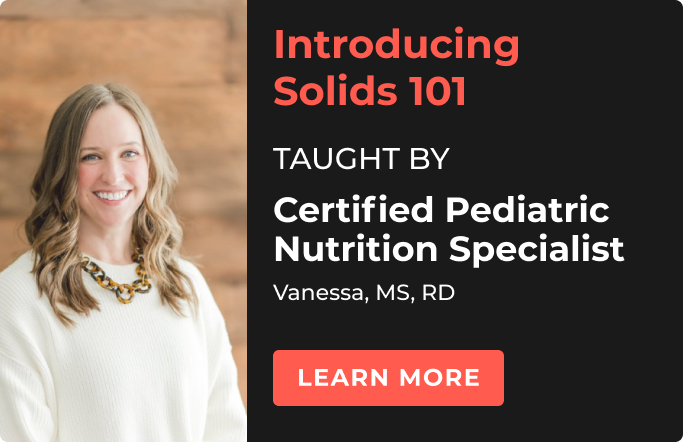As baby’s first Thanksgiving rolls around, you are probably excited to include your newest family member in all the holiday festivities. And what does Thanksgiving involve? Lots and lots of eating! For those families still getting the hang of solids, we asked our expert Pediatric Nutritionist to give you some tips for how to safely include your baby in the Thanksgiving feast.
Before we jump into what foods to serve and some ways to serve them, let’s cover a few solid food basics.
Firstly, make sure baby is ready. And by that, we mean to make sure they are 1) at least 4 months old (though most babies are ready closer to 6 months) and 2) Sitting up with good head control.
Second, know your feeding options. Will you be spoon-feeding your child purees or offering them the chance to self-feed through Baby-Led Weaning? If you’re not sure the answer, Tinyhood’s Introducing Solids 101 course will walk you through both options, and how and why you might implement each of them.
Third, be aware of potential allergens. While babies can have an allergic reaction to almost any kind of food, the top 8 triggers are: cow’s milk, soy, peanuts, tree nuts, fish, shellfish, wheat, and eggs. You may want to avoid giving a high-risk food for the very first time at the Thanksgiving dinner table. If you plan to use any of these foods (like dairy) in Thanksgiving recipes, try offering dairy a few days before to check for an allergic reaction.
And fourth, set yourself up for success. Feeding your child in these early days isn’t just about nutrition, but it’s a great way to bond. So pull that high chair right up to the table, and prepare for potential messes by bringing a bib, a splash mat, and a change of clothes.
Now, on to the main event! Let’s go through some favorite Thanksgiving foods and how you can safely introduce them to your baby, whether you are choosing to offer them as a puree or serving them whole in the style of Baby-Led Weaning.
1. Turkey
To puree: Mix with water, formula, breast milk or broth puree to your desired consistency.
For Baby-Led Weaning: Remove the skin and offer a strip about ½-1 inch thick of light or dark meat. Or, you can offer a drumstick for baby to gnaw or suck on. (Psst — this option makes for a great photo opp!)
2. Mashed Potatoes
This is an easy one for the puree AND Baby-Led Weaning crowd… just serve it! If you want, you can also add a little liquid (breast milk, formula, cow’s milk, broth, water) and use a fork to mash to your desired consistency. This is particularly helpful if the potatoes are a bit gummy.
3. Sweet potatoes
Same as above! If they are mashed, you can more or less just serve them. Avoid classic sweet potato casseroles though, as marshmallows have unwanted added sugar and are also a choking hazard.
4. Pumpkin/Butternut Squash
Again, the recommendation is largely the same as it was for potatoes. Just remember, pumpkin pie is not the same as pumpkin. It’s best to keep babies away from the amount of added sugar in a pumpkin pie.
5. Carrots (glazed or steamed)
Avoid recipes that contain honey as babies under 1 year are at increased risk of botulism. As this dish traditionally has a lot of added sugar, set aside carrots to cook plain then add your own Thanksgiving seasonings (like cinnamon or nutmeg) for baby.
To puree: Blend with your liquid and seasonings of choice.
For Baby-Led Weaning: Make sure they are soft to the touch! This dish might require a little extra cooking before you serve it. Just make sure to avoid coin shaped pieces.
6. Cranberry Jelly/Sauce
In general, we say no added sugar in babies’ diets — but HEY it’s the holidays and just one meal. Treat this as a condiment to taste and not a “dish.” Generally, the texture of these are great for purees and Baby-Led Weaning, but make sure to scan for any whole cranberries, as these can be a choking hazard. You can offer plain or stir a small dollop into sweet potatoes or mashed potatoes to expose your baby to a new flavor: tart!
7. Stuffing
To puree: Blend with your liquid of choice, or add some liquid and mash with a fork.
For Baby-Led Weaning: Just serve! Break up any particularly large pieces, though, to avoid any gummy clumps, and make sure any vegetables are cooked properly.
8. Bread/Rolls
Technically, this can be pureed, but mashed potatoes, sweet potatoes, and stuffing provide more festive carbohydrate options.
For Baby-Led Weaning, lightly toast bread or rolls to avoid large, gummy clumps of bread. Feel free to add butter or spread some other Thanksgiving foods like stuffing or potatoes on top.
9. Green beans
To puree: Blend with broth or gravy without added salt.
For Baby-Led Weaning: Remove any hard ends and steam or bake until they are soft to the touch, and serve whole. You can even give green bean casserole as long as the beans are soft enough.
10. Brussel sprouts
To puree: Blend steamed sprouts with the liquid of choice. Feel free to add some seasoning to this one.
For Baby-Led Weaning: Brussel sprouts can be tough, so steam them well, and cut into quarters or shred them.
Some final thoughts and tips…
Combine foods. If baby is low-risk for allergies, feel free to combine several foods into one puree, or give baby several different options when it comes to self-feeding.
Offer flavor. Don’t shy away from traditional Thanksgiving seasonings (cinnamon, nutmeg, sage, thyme, rosemary, etc).
Avoid dessert dishes. A little sugar in certain dishes is fine and oftentimes unavoidable, but it’s too soon for the level of added sugar found in desserts. Remember “added sugar” doesn’t just include white and brown sugar, but maple syrup, honey, agave, and fruit juices. If you really want baby to get in on the fun of dessert (keep in mind this is a fun, bonding experience!) offer baked apples with cinnamon.
Watch for choking hazards. These include raw/undercooked veggies, whole or large pieces of nuts, marshmallows, gummy foods (add liquid to revitalize potatoes, breads, stuffings), whole cranberries, coin shaped or large chunks of vegetables.
Keep a close eye on baby. This goes back to the choking hazards bit, but remember that the Thanksgiving table is a lot more chaotic and distracting than baby is probably used to. Make sure you’ve refreshed your Child CPR & Choking skills to keep everyone safe.
Most importantly, remember this is just one meal. While every “first” is an exciting one, don’t put too much pressure on yourself. Don’t try foods you aren’t comfortable with, and don’t stress too much if baby’s salt or sugar intake is higher than normal. Whether you are going somewhere and aren’t sure of the menu or cooking yourself, it’s a good idea to have some “safe foods” you know baby likes already that you can offer come meal time. The most important thing is enjoying yourselves and sharing a meal together!
For more on introducing solids to your baby, including real finger foods, watch our on-demand class collection Introducing Solids 101.




